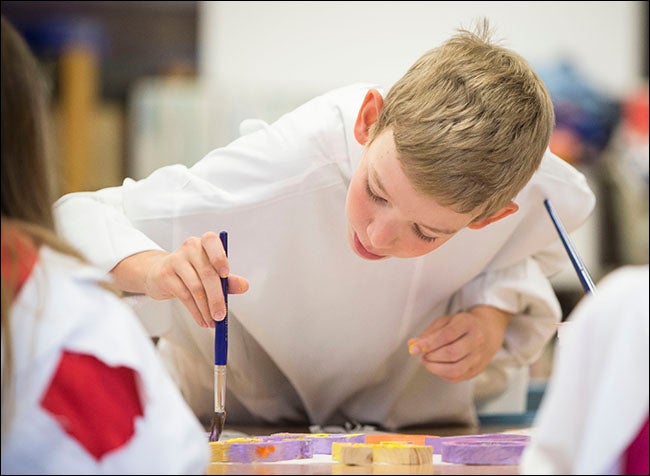EXPLORING CONNECTIONS
STEM to STEAM camp links visual arts to technology
East Carolina University’s first STEM to STEAM summer camp challenged 25 elementary to high school students to make connections between technology and art.
Hosted by the School of Art and Design July 21-25 in Jenkins Fine Arts Center, the art-focused camp combined elements of science, technology, engineering and math (STEM) with the added discipline of visual arts (STEAM).
“The students didn’t know how the STEM disciplines would play into art,” said Robbie Quinn, camp director and associate professor of art education in the School of Art and Design. “This week has been eye-opening in that way.”
In most public schools, math, science and art are taught separately, Quinn said.
“All of these disciplines need to be called upon to work together,” Quinn said. “We hope to use the art learning as a way to make the STEM concepts visible. Our real hope for the students is that they would see the power of whole-brain learning, that they’re able to make connections among disciplines.”

Camper Chad Styron paints letters that will be attached to the Peace Pole project for the International Day of Peace Sept. 21.
At the camp, elementary students constructed rainbow fish out of paper bags after learning about the technology needed to operate fish farms, which helped relate the STEM to STEAM concept, said Alie Brooks, a senior ECU art education student from Rockville, Maryland, who taught 4-year-old to 6-year-old students.
Brooks shared how fish farms provide food and encouraged the students to tell their parents to buy local seafood. “It is so available, and it does relate to them a lot,” Brooks said, because of Greenville’s proximity to the North Carolina coast.

Kaeden Harris creates a rainbow fish using a paper bag and colored markers, an activity followed by discussion of how technology is used in operating fish farms.
The children colorfully decorated the brown paper bag fish stuffed with newspaper. They attached the fish to blue construction paper, providing a backdrop for an underwater scene.
“I love your color selection,” Brooks told one student.
“I’m making my fish angry because someone is flashing a light on him,” student Mason Bowler said.
“I made a tadpole and the tadpole is splashing out,” camper Kaeden Harris said.
“A lot of art education students at other universities don’t get to experience working with students until their last year of school.”
Daniel Niece, a visual arts teacher and soccer coach at E.B. Aycock Middle School, planned to lead lessons using cardboard. Sixth through eighth-graders used SketchUp software to design houses for extreme environments. “Everything is to scale,” he said. If you designed a home in the jungle, what materials would you use, he asked.
 High school students at the camp made lighted key chains out of acrylic using traditional jewelry tools such as a saw, file and pliers. ECU metal design graduate student Sarah Loch-Test helped troubleshoot for the students.
High school students at the camp made lighted key chains out of acrylic using traditional jewelry tools such as a saw, file and pliers. ECU metal design graduate student Sarah Loch-Test helped troubleshoot for the students.
Danielle Vaughn, a rising junior at South Central High School in Winterville, carefully moved a small coping saw to create her key chain’s form. Vaughn said she wanted to attend the camp because she “wanted to learn something new in a nearby location.” She had looked into camps in other states, but chose the one at ECU. She plans on majoring in art in college.